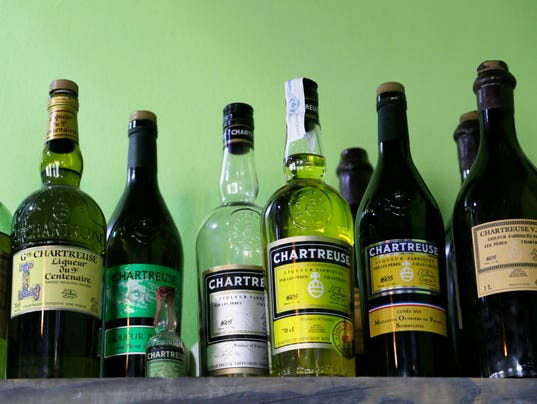 One day in 1605, the Chartreuse monks in Paris received a manuscript of an Elixir, soon to be known as "the Elixir of long Life". Since then, the monks dedicated their life to produce this wonderful product. Amazing !! Can you believe it ? More than 400 years of history and legacy, and the Chartreuse is still the most mysterious liqueur in the World.
One day in 1605, the Chartreuse monks in Paris received a manuscript of an Elixir, soon to be known as "the Elixir of long Life". Since then, the monks dedicated their life to produce this wonderful product. Amazing !! Can you believe it ? More than 400 years of history and legacy, and the Chartreuse is still the most mysterious liqueur in the World.
Chartreuse, a French liqueur made by the Carthusian Monks since 1737 according to the instructions set out in a manuscript given to them by François Annibal d'Estrées in 1605. It is composed of distilled alcohol aged with 130 herbs, plants and flowers. The liqueur is named after the monks' Grande Chartreuse monastery, located in the Chartreuse Mountains in the general region of Grenoble in France. The liqueur is produced in their distillery in the nearby town of Voiron (Isère). Until the 1980s, there was another distillery at Tarragona in Spain.
Every year on May 16th (16.05), we pay tribute to this unique liqueur and the people who like to share good moments with our Favourite French Elixir. And for those lucky enough, there will be different kinds of presents !
#ItsBecauseItsFrench #1605Chartreuse #ChartreuseDay
The two types of Chartreuse are:
- Green Chartreuse (110 proof or 55%) is a naturally green liqueur made from 130 herbs and plants macerated in alcohol and steeped for about 8 hours. A last maceration of plants gives its colour to the liqueur.
- Yellow Chartreuse (80 proof or 40%), which has a milder and sweeter flavour and aroma.
 Also made by the monks of Chartreuse are:
Also made by the monks of Chartreuse are:
- Chartreuse VEP
- VEP stands for Vieillissement Exceptionnellement Prolongé, meaning "exceptionally prolonged ageing" in English. It is made using the same processes and the same secret formula as the traditional liqueur, and by extra long ageing in oak casks it reaches an exceptional quality. Chartreuse VEP comes in both yellow and green.
- Élixir Végétal de la Grande-Chartreuse (138 proof or 69% – also 142 proof or 71%)
- The same base of about 130 medicinal and aromatic plants and flowers; far stronger. It can be described as a cordial or a liqueur, and is claimed to be a tonic. Sold in small wooden-covered bottles.
- Liqueur du 9° Centenaire (47%)
- Created in 1984 to commemorate the 900 year anniversary of the foundation of the abbey. It is similar to Green Chartreuse but slightly sweeter.
- Chartreuse 1605 – Liqueur d'Elixir (56%)
- Created to commemorate the return of a mysterious manuscript concerning an elixir of long life to the Carthusian monks by Marshal François Annibal d'Estrées.
- White Chartreuse (30%)
- Produced and sold between 1860 and 1900.
Chartreuse has a very strong characteristic taste. It is very sweet, but becomes both spicy and pungent. It is comparable to other herbal liqueurs such as Galliano, Liquore Strega or Kräuterlikör, though it is distinctively more vegetal. Like other liqueurs, its flavour is sensitive to serving temperature. If straight, it can be served very cold, but is often served at room temperature. It is also featured in some cocktails. Some mixed drink recipes call for only a few drops of Chartreuse due to the assertive flavour. It is popular in French ski resorts where it is mixed with hot chocolate and called Green Chaud.
Chartreuse gives its name to the colour chartreuse, which was first used as a term of colour in 1884. It is one of the handful of liquors that continue to age and improve in the bottle.
 Patti Neumann is Founder of Sip & Swirl Society, Wine & Spirit Rep @ Constantine Wines & Publisher of CITYPEEK.com, an award-winning blog. Email ceo@citypeek.com
Patti Neumann is Founder of Sip & Swirl Society, Wine & Spirit Rep @ Constantine Wines & Publisher of CITYPEEK.com, an award-winning blog. Email ceo@citypeek.com
Connect with CITYPEEK we Peek into the World of Food & Wine, Beer & Craft Spirits:
 Facebook: Click
Facebook: Click
 Twitter: Click
Twitter: Click
 Instagram: Click
Instagram: Click
 LinkedIn
LinkedIn

 Add Events
Add Events Food, Wine & Travel News
Food, Wine & Travel News
 One day in 1605, the Chartreuse monks in Paris received a manuscript of an Elixir, soon to be known as "the Elixir of long Life". Since then, the monks dedicated their life to produce this wonderful product. Amazing !! Can you believe it ? More than 400 years of history and legacy, and the Chartreuse is still the most mysterious liqueur in the World.
One day in 1605, the Chartreuse monks in Paris received a manuscript of an Elixir, soon to be known as "the Elixir of long Life". Since then, the monks dedicated their life to produce this wonderful product. Amazing !! Can you believe it ? More than 400 years of history and legacy, and the Chartreuse is still the most mysterious liqueur in the World. Also made by the monks of Chartreuse are:
Also made by the monks of Chartreuse are: Patti Neumann is Founder of Sip & Swirl Society, Wine & Spirit Rep @ Constantine Wines & Publisher of CITYPEEK.com, an award-winning blog.
Patti Neumann is Founder of Sip & Swirl Society, Wine & Spirit Rep @ Constantine Wines & Publisher of CITYPEEK.com, an award-winning blog. 